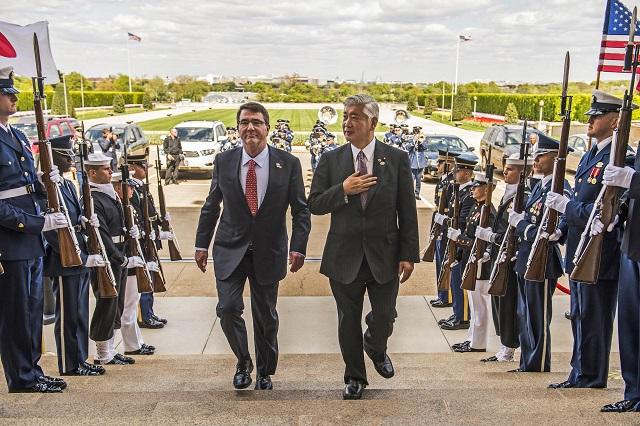The new US–Japan Guidelines for Defense Cooperation (PDF) and the accompanying joint statement by the two countries’ foreign and defence ministers commit both sides to do more with each other in relation to third countries than did the much shorter 1997 guidelines when the East Asian security situation was less fraught.
The first reading of the guidelines from a Southeast Asian perspective suggest that one of the East Asian goals of the US rebalance is well on the way to being realised, while another one may not be so. On the positive side, as successive US Quadrennial Defense Reviews have repeated, the US has long sought greater support from allies and security partners in East Asia. The rebalance isn’t only a commitment by the US to update its forward defence commitments in East Asia (and ring-fence them from sequestration) but also a reciprocal opportunity for its treaty allies and growing number of security partners to provide greater support to the US.
In Northeast Asia, Japan, as shown by these new guidelines (and earlier unilateral defence reforms), has grasped this opportunity both for the defence of Japan and for supporting regional security through the guidelines’ new foci on third country contingencies, ballistic missile defence and cooperation on regional capacity building. South Korea, as shown by its continuing hesitancy over the deployment of a THAAD battery, less so.
In Southeast Asia, broadly defined, Australia has also grasped the opportunity to support the US role in regional security, as shown by the US marines in Darwin, greater US access to Stirling naval facilities, among other moves. Singapore’s decision to home port US littoral combat ships likewise, while the Aquino administration’s politically painful commitment to the Enhanced Defense Cooperation Agreement with the United States shows greater Philippine support for a larger US role in Philippine defence. Thailand, as shown by its hesitancy for US forces to use Thai air facilities, less so.
Three factors—two from the guidelines themselves and one external to them—suggest that the rebalance’s greater emphasis on Southeast Asia is harder going.
- the accompanying joint statement to the new US–Japan guidelines state that ‘the Ministers also reaffirmed that the Senkaku Islands are territories under the administration of Japan and therefore fall within the scope of the commitments under Article 5 of the U.S.-Japan Treaty of Mutual Cooperation and Security, and that they oppose any unilateral action that seeks to undermine Japan’s administration of these islands.’ No such commitment exists for Philippine claims in the South China Sea for islands administered by the Philippines. The US commitment in Northeast Asia is deeper than in Southeast Asia when it comes to territorial disputes involving China.
- The guidelines commit Japan and the US to significantly deepen and broaden the alliance. That’s evidenced in the establishment of a whole-of-government Alliance Coordination Mechanism, joint surveys of Japanese civilian airports and seaports for the use of US and Japanese forces, and by the new capabilities the US and Japan are bringing to the alliance particularly in relation to ballistic missile defence as listed in the joint statement. In contrast, the 2014 AUSMIN meeting led the US and Australia to commit to ‘establishing a bilateral working group to examine options for potential Australian contributions to ballistic missile defence in the region.’ These points reflect how much deeper and more central the US–Japan alliance is to US forward defence in East Asia than is ANZUS. That’s due to the much larger size of the Japanese military, the presence of so many US assets in and around Japan and Japan’s geographical location as a maritime neighbour of both China and North Korea. US forces and capabilities in East Asia have always been heavily unbalanced in favour of Northeast Asia, as have regional forces supporting the US presence. This will continue.
- American certainty over Japan’s reciprocal commitment to the rebalance is—or should be—stronger than the certainty granted to key allies and partners in Southeast Asia, Australia excluded. The 2016 Philippine election could lead to a significant change in the Philippine policy on its territorial disputes with China. Many fear (or hope) that the Philippine Supreme Court will strike down the Enhanced Defense Cooperation Agreement and the access it provides the US to Philippine military facilities. The Philippine rebalance to the US could be undone.
The new US–Japan guidelines make specific mention of enhancing trilateral and multilateral cooperation. To take full advantage of these new, more robust guidelines, Australia should continue to strengthen its security partnership with Japan and the well-functioning trilateral relationship, and make a clearer commitment on regional ballistic missile defence. This would help ensure that the rebalance’s greater emphasis on Southeast Asia is supported not sidelined.
